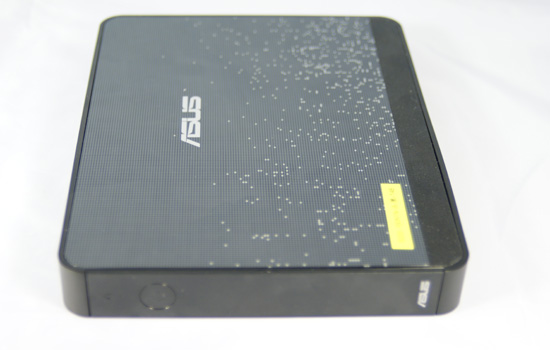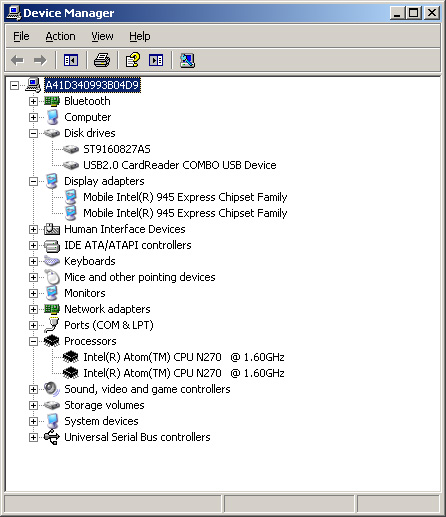ASUS Eee Box Preview & Intel's Atom Benchmarked
by Anand Lal Shimpi on June 3, 2008 12:00 AM EST- Posted in
- Systems
The Internet today is far more functional than it ever was and we’re finally at the point where being able to access the net in places like your living room, bathroom or kitchen is actually pretty useful. Recipes are no longer stored in cookbooks, they are in emails or websites. There’s a website or forum for virtually everything, not to mention the utility of sites like Wikipedia and imdb.
The problem is that a kitchen PC that could be used to check emails, look up recipes or chat with someone while cooking wasn’t really feasible when decent PCs would set you back at least $1500. As PC prices fell however, the possibility of putting a PC in nearly every room of your house increased tremendously. We’ve already established that there’s utility in such a PC-filled household, but what was left is someone to provide the hardware to make it happen.
When the One Laptop Per Child (OLPC) project was started it didn’t take long before regular computer users took notice and also wanted access to a $100 - $200 PC. It wasn’t just the end users that realized there was a need for such a machine, some of the manufacturers did too.
Before the release of the ASUS Eee PC I had dinner with ASUS’ CEO, Jonney Shih and we began talking about what was necessary to build a truly lightweight, yet functional PC. Jonney isn't your typical CEO, he's still quite an engineer at heart and enjoys discussing everything from market direction to the microprocessor architectures necessary to make that direction happen. The conversation started about the OLPC project but quickly lead to what it would take to build such a thing for the mainstream consumer market. We discussed what was possible, but little did I realize that ASUS had already begun working on such a thing.
The Eee PC was ASUS’ first attempt at a cheap machine for the masses, unfortunately as a notebook it’s a tough sell for most. The keyboard is cramped and the screen is too small to be productive on. People either loved or hated the Eee PC, but the system generated enough interest and was selling well enough that ASUS went ahead with plans to build a desktop equivalent.
Since they called the notebook the Eee PC, the desktop had to have a different name and thus it was called the Eee Box.

The Eee Box is effectively a headless notebook with no keyboard/mouse. In fact, the new version of the Eee PC features the exact same hardware configuration as the Eee Box - just in notebook form. Using notebook components in a “desktop” PC is nothing new, Apple does it all the time with the majority of its machines. The iMac uses a mobile CPU, as does the Apple TV, despite neither one being a notebook.
Stylistically, ASUS did a tremendous job with the Eee Box. The system we have here is an early prototype, the final version will be available with a solid white or black finish (the random pixel pattern on our system won’t make it to production). The machine is extremely sleek measuring 17.7 cm x 22.1 cm x 2.7 cm (6.97" x 8.7" x 1.06").
Without a keyboard or display to complain about and an even lower price tag ($269 or $299 depending on configuration), we set off to see if the Eee Box would have more universal appeal than the Eee PC.
The Configurations
There have been rumors a plenty about the standard configurations that the Eee Box would be available in and we’re finally able to give you the exact specs of the three North American models:
| OS | CPU | Memory | HDD | Price | |
| ASUS Eee Box | Linux | Intel Atom 1.6GHz | 1GB | 80GB 2.5" 5400RPM | $269 |
| ASUS Eee Box | Windows XP | Intel Atom 1.6GHz | 1GB | 80GB 2.5" 5400RPM | $299 |
| ASUS Eee Box | Linux | Intel Atom 1.6GHz | 2GB | 160GB 2.5" 5400RPM | $299 |
The base Eee Box configuration will retail for $269 and feature a 80GB SATA HDD, 1GB of memory and ship with Linux.

The same configuration with Windows XP will run you $299, or for the same amount of money you can purchase a 160GB/2GB system also with Linux. Microsoft won't allow PCs to be sold with > 80GB HDDs preloaded with Windows XP and thus the top end configuration is only available with Linux. Given our experience with the Eee Box under Vista vs. XP (which we'll get to shortly), we think that this is the perfect example of Microsoft dropping the ball and easily losing ground to open source solutions here.
All three machines will ship with the same Intel Atom processor running at 1.60GHz on ASUS’ own 945G based motherboard.
Availability is planned for July in North America although machines will first be available in Asia before then.










35 Comments
View All Comments
Casper42 - Tuesday, June 3, 2008 - link
Gigabit Network with 2 USB Ports means you could make a sidecar that holds a small Power supply and 2 Desktop Drives (1TB Each) and plug them in USB.That gives you a SATA Boot drive and then either 2TB in RAID0/JBOD or 1TB in RAID1
Small enough to not run up your power bill like crazy and yyet still flexible enough to run your OS of choice for the hosting platform and any other little utilities you might want (cough BT Client cough).
erikstarcher - Tuesday, June 3, 2008 - link
Looks like it would make a great car pc. hook up a 7" touchscreen to it for control and you are set. I bet it would do music, video (non hd) and gps without a problem. And it won't kill your battery as fast as some other solutions (like the laptop I am now using).Yooshaw - Tuesday, June 3, 2008 - link
This was my first thought - you could really make a killer Carputer with this thing.strikeback03 - Wednesday, June 4, 2008 - link
I thought that as well, though would almost certainly need a USB audio solution due to lack of other expansion. And the loud fan would be annoying too. I hope some more small devices/components come out for Atom/VIA Nano soon.MooseMuffin - Tuesday, June 3, 2008 - link
Splashtop is a killer idea. There's been plenty of times where I've hosed my OS in some way, and this provides a way to still go online and google a solution.LuxZg - Tuesday, June 3, 2008 - link
I agree, and this is one thing that is nice about Eee Box. But since it IS available on other MBOs as well, it's not huge advantage..pnyffeler - Tuesday, June 3, 2008 - link
How does the Atom perform for Remote Desktop and/or any other remote connections, with or without VPN? I just wonder how well this would work for working from home if your company offers such remote options.Martimus - Tuesday, June 3, 2008 - link
I like seeing that Microsoft isn't allowing Windows XP on machines with larger than 80GB HDs. That should help establish a larger foothold for Linux on these types of computers. Of course when marketshare gets bigger, so will the compatibility which means that an alternative OS might actually be feasible. All this caused by Microsoft's attempt to maximize profits in the short term. Looks more like they are shooting themselves in the foot in the long term. I hope this type of computer really catches on and causes Linux or some other OS to really become mainstream.Griswold - Tuesday, June 3, 2008 - link
Put a VIA Nano (C8) in that thing and I'm interested. Atom looks like s ure loser (but will be punched through with Intels might) for anything bigger than Intels envisioned MIDs.eeebox - Tuesday, June 3, 2008 - link
People go on about it not being usable as a Media streamer, can't do HD yada yada...but is it powerful enough to be used as a SDTV recorder using a USB DVB-T tuner? I'm not even too fussed about record and play at the same time, simply record. It's been confirmed it can play 4.5Mbps 720p H.264 at 90% and 720p Divx fine so that means it should be able to play SD perfectly fine, so how would it handle the encoding side of it for recording?Seeing as though it'll cost only a little bit more than an average HDD TV recorder I want to get an eeebox for use as a compact low power HDD SDTV recorder with easily replacable HDD and a web browser (Splashtop ftw) and the VESA mounting to the back of a TV is perfect as I use my TV as a monitor.